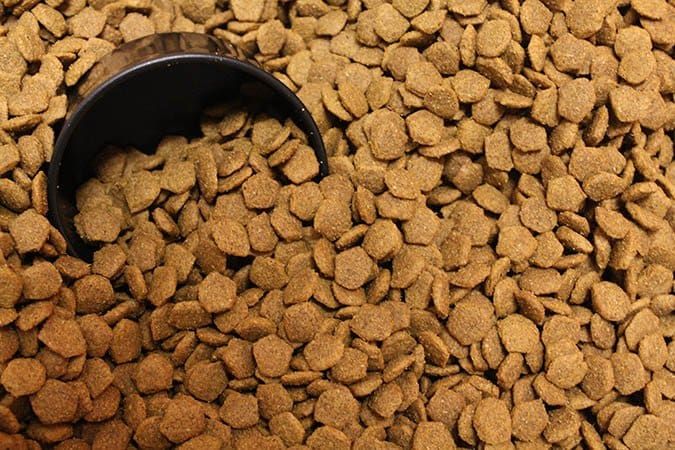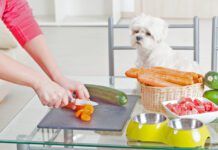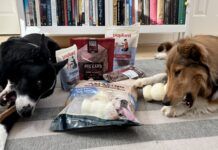[Updated June 26, 2017]
For those of you just coming on board: In the July 2000 issue, we published an article called “Hidden Killer in Dog Food.” The article was inspired by a “case history” we received from a reader who had been through a harrowing experience with her dog. It took the reader several months – and a small fortune – to determine that the sudden onset of very strange and serious neurological problems with her dog was caused by a naturally occurring toxin in her dog’s food.
As we stated in that article, a number of toxins can arise in dry dog food during its production, storage, and transportation. Most of the toxins are produced by various molds that grow in the food, or in certain ingredients of the food, and are referred to generally as “mycotoxins.”
Some mycotoxins are highly dangerous to dogs; “aflatoxin,” the substance that made our reader’s dog ill, is one of these. Aflatoxin generally causes neurological problems in its victims, and it can kill dogs (and it has), though some dogs are more sensitive to the substance than others. It should be noted that aflatoxin is already present in the raw foodstuffs before they are made into food; dog food manufacturers generally test for the presence of aflatoxin in the foodstuffs they receive prior to making them into food.
“Vomitoxin” is another, more common mycotoxin. As the name suggests, it tends to cause digestive disturbances, and while it can kill vulnerable individuals, it usually only makes them sick for a short period of time following consumption.
Neither of these mycotoxins are necessarily visible or easily detected by smelling the food.
Visible Mold is Another Matter
Recently, we’ve had the unfortunate opportunity to learn that there are other molds that can grow on dog foods without being toxic. We say “unfortunate” because just as our article about mold and mycotoxins was being read by thousands of subscribers, a mold problem had raised its ugly head in the products made and marketed by at least two dog food companies: Natura Pet Products and Natural Balance. We heard the names of a few other foods as well, from one person apiece, which would seem to confirm what we stated in the July article: Under the “right” conditions, any dry dog food can mold, whether it is naturally or artificially preserved.
We need to stress this: Just because a food is moldy, doesn’t mean it contains mycotoxins or is toxic. However, ingesting the moldy food can cause temporary stomach upset in some dogs; other dogs seem to handle it without incident. Certain dogs who are allergic to molds may have an allergic response. But these responses are nowhere near as dramatic or dangerous as a brush with mycotoxins like aflatoxin or vomitoxin.
Prevent Mycotoxin Poisoning AND Problems with Mold
We’ve updated the following list of recommendations concerning dry dog food, mold, and mycotoxins:
• Check the date of manufacture on the food you buy. Try to buy foods that are as fresh as possible.
• If you discover mold on the food you buy, return the remaining product to the store where you bought it and ask for a replacement. If the store management is unwilling to replace your food, contact the food maker. They will undoubtedly wish to make things right and replace the food.
• Purchase smaller bags of food so you don’t have to store it for long.
• Keep your dog’s food in a dry place with a cool, stable temperature. Temperature swings from hot to cold can cause moisture to develop in a food bag or plastic tub. Moisture, especially in combination with heat, can trigger the growth of molds, and toxins may develop in the food.
• Experts suggest that you do NOT dump dry food out of the bag into a plastic container, as moisture and mold can accumulate on the plastic over time. And old kibble on the bottom of the barrel is more likely to mold and infect the newer food.
• Never feed your dog food that has gotten moldy or smells “off.” Never pressure your dog to eat food that he refuses, especially if he vomits after eating some of it.
• If your dog develops strange behaviors or signs of illness soon after eating – or shortly after you start feeding him from a new bag of food – immediately discontinue feeding him that food. Return the food to the store where you purchased it.
Inquiries About Foods
But we had dozens of reports about Natura’s Innova and California Natural, and a few reports about Natural Balance’s Ultra Premium food – all three of which, not incidently, we have included on our past lists of “Top 10 Dry Dog Foods.” All over the country, dog owners were ripping open bags of these foods, and discovering kibble that was covered with a powdery whitish or greenish mold. Some of these people were terrified by the fact that in their bags, the mold was not discovered until they were halfway into the bags; their dogs had eaten some of the moldy food. Suddenly we were getting inundated with calls and letters regarding these moldy foods: Were they dangerous?
Natural Balance Responds
We turned to the companies themselves. We had an immediate response from Frank Coch, the Executive Vice President of Sales and Marketing for Natural Balance, who flatly stated that yes, indeed, they had some problems with mold on their food in May and June.
Coch stated that the problem originated at the plant that made the food, and was caused by an overly high moisture content in some of the food. When the moisture in a dry food exceeds 10 percent, he told us, mold can develop on the food in the bag, especially in warm weather conditions. “It can – and does – happen to any and every food occasionally,” Coch said.
Coch also stated that their tests indicated that the mold was not toxic, but it was unpalatable and unattractive cosmetically.
“What have you done about the problem?” we wanted to know. Coch stated that, fortunately, they had discovered the problem fairly early on, and had been able to isolate the problem to certain production runs and to pull most of the affected bags off the shelves before too many consumers had taken the food home. People who did purchase the moldy food were encouraged to return it for a new bag of food.
Most importantly, Coch said, Natural Balance had moved production of the food to a new manufacturing plant in another state. “We’re selling a high quality natural product, and if the manufacturer can’t do it right, we have to find someone who will,” he said.
We asked Coch whether this was a difficult decision to make; surely there were financial repercussions of such a move? “In that particular matter,” Coch responded, “we had to do the fastest thing possible, and that was to get the food into proper production so it didn’t happen again. The financial side of it we’ll address later.”
Our next question prompted an unexpected level of candor. “How is it,” we asked, “that you had the instinct to deal with this so quickly and with such force?” Coch responded, “Well, let’s see. About four or five years ago, when I was a vice president at Nature’s Recipe, we had a $20 million recall due to a problem with vomitoxin. That was probably the most serious recall I’ve ever seen in the pet food business – and I guess it taught me a few things.”
According to Coch, the problem with Nature’s Recipe bloomed into a bigger problem than it should have, as the company investigated the cause and extent of the problem, and, Coch says, released several different versions of the event to those who inquired. Coch admitted that it looked bad, even though it was not meant as a cover-up or a denial. “We thought at first that it was an isolated problem, and that we had it taken care of. And then it turns out that it was a global problem. We thought we had the problem solved, and then came to find out that, ‘Oh, guess what guys? It wasn’t just that run; it was the last 50 runs.’ It was a nightmare.”
While Natural Balance is not nearly as big as Nature’s Recipe was at the time of the vomitoxin incident (it has since been acquired by Heinz), and while the scale and seriousness of the current mold incident is not nearly as extensive, Coch says it’s just as unacceptable. “We (Natural Balance) are making a top quality food, and we want it to be the healthiest food possible. We ascertained that the plant that was making the food for us didn’t have the capability of correcting the problem, so we pulled out of there,” he says.
Natura’s Response…
At our request, Natura sent us a statement in response to our questions about the incidents of mold in their Innova and California Natural foods, and indicated their willingness to answer more of our questions. Unfortunately, this communication occurred on the very eve of publication. We hope to include their answers to our follow-up questions in the next issue.
We have some concerns, since we have learned that at the time of the mold incident, Natura’s foods and those made by Natural Balance were being made by the same manufacturing plant in New York. The powers-that-be at Natural Balance decided that the manufacturer could not remedy the problem to their satisfaction. We are eager to learn how (or if) that manufacturer satisfied the powers-that-be at Natura that the moisture problem was resolved.







Is thereanynew complaints with the natures recipe dog food? I just recently found mold atthe bottom of a dog food and I now have a sick dog. I wrote the company andtheyaresending me a coupon to replace it and my dog is going to the vet this week. I just wondered if there is anything new Ineed to know about.
dogs are getting sick in canada and usa too
Science Diet. My Vet said to not feed anything else at least until her stomach healed from ingesting something. Today, After opening w can, I noticed black mold all over the top and partially down the sides. 2 days ago I noticed a small piece of something black but I scraped it off and discarded it. This dog is a chewer and a healthy eater but, she would not eat it, at all. I finally put a little boiled chicken about an inch square with it, even though The vet said not to but it had been 2 days since she ate. Another time I put plain chicken broth. She picked the chicken out a time or two and finally ate about 1/4th cup of the canned food one day in the last 4 days. I unknowingly and literally starved my dog going on 4 days because of that. I am so horrified, I would NEVER… I’m in tears. She is back to her regular dog food (soft for her stomach) until we go back for a check up in a few days. It’s not the vets fault. I always heard bad things about this brand but I thought it was the taste the dogs didn’t like. Animals know.
Was science diet the problematic dog food? I’m having issues with science diet but the vet thinks I’m wrong. Neurological issues!
I recently started working at a dog food company giant bins full of moldy carrots everywhere. I have dogs myself don’t want to lose my job but really need to find a way to report this?
They’re all made exactly the same their is no difference in canned dog food we make all brands from blue to science to makersmark
I have been buying a type of Fromm since 2007-2008. Have had no problems , until about a month ago, I noticed they were eating tons of grass. I always check the dog food before putting it in their metal can . 1 bag lasts about a week and a half . 2nd bag bought from same location ( which i have been shopping at for years – cat food too~ love them ) now its really upset the stomachs of 2 of my dogs. Stopped feeding/stopped eating. All 4 for now are eating pumpkin. Ive written Fromm and asked of changes . Nothing yet. Researching, spoke to my vet if anyone else is having problems.. looking at the top 7 dog foods of 2021 or considering chicken & rice & mixed vegetables as their new diet. Not sure if its a fungal problem , but 1 pup is showing another type of a fungal on the belly. Have now added Braggs to their water and as a topical. I dont think its the dog food , but instead in transit & possibly storage.
I was part way through a bag of Natural Balance L.I.D. Lamb & Brown Rice Formula Dry Dog when I saw mold covering a lot of kibble. I found this article after searching info about moldy dry dog food. Sure hope my dog doesn’t get sick.